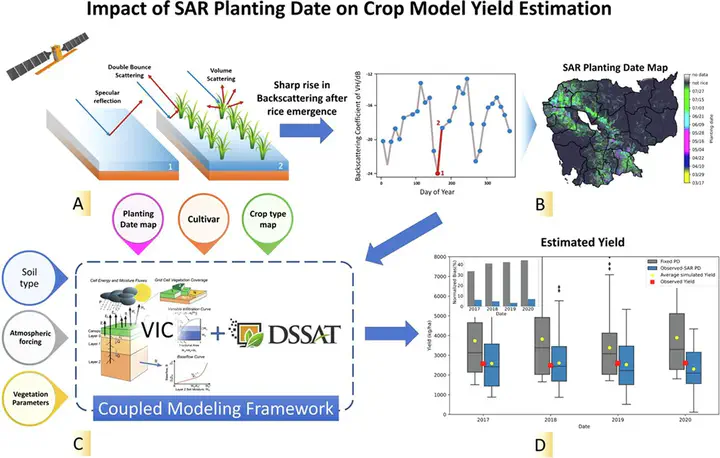
Abstract
Planting date (PD) is one of the critical component in crop modeling that has a large-scale impact on seasonal yield estimation. Here, we aimed to estimate the various paddy/rice attributes (particularly, acreage and PD) using the Sentinel-1A observations, and assessing the impact of such key parameters on end-of-season yields. The method comprises: (1) a multi-temporal time-series analysis algorithm of Sentinel-1A observations for rice mapping, (2) a PD retrieval algorithm, and (3) rice yield estimation using the Synthetic Aperture Radar (SAR)-derived PD in a modeling system. Our study was implemented over the rainfed paddy fields in Cambodia be-tween 2017 thru 2020. We demonstrated that the backscatter ratio (sigma VH 0 sigma VV 0) from Sentinel-1A can improve the accuracy of rice mapping, while sigma VH0 backscatter can provide PD estimations. Our results showcased reasonable/ good performance in mapping the paddy fields and estimating PD in the study area. PD found in March and April were indicative of irrigation application in some parts of Cambodia, specifically in the southeastern part (also part of the Mekong delta) where irrigation in paddy fields is a common practice. Differences between the crop -calendar based PD (June 1) and the SAR-derived PD can range as much as 75 days. In the rice-dominated provinces such as Banteay-Meanchey and Svay-Rieng of Cambodia, when SAR-derived PD are used, rice yield normalized bias improved compared to the fixed PD data by a mean of 7-12 % and 30-48 % respectively within the study period. In addition, the PD derived from SAR also significantly reduced the uncertainty in yield esti-mation. Overall, this study demonstrated the potential of using the SAR-derived PD in improving the rice yield estimation over rainfed paddy fields.